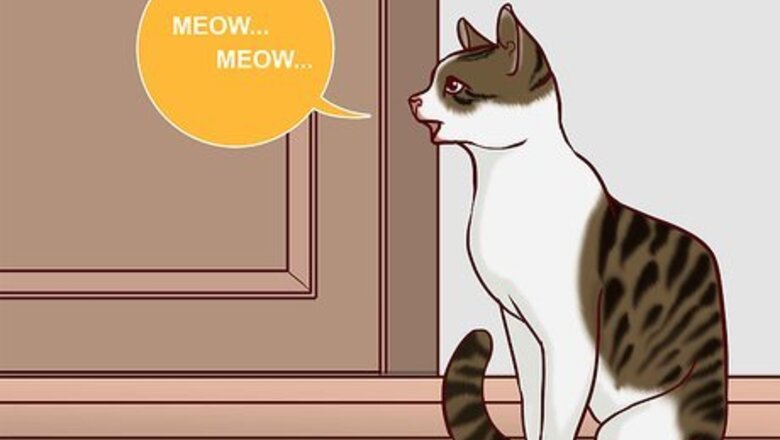
views
Deciphering Cat Noises

Pay attention to vocal meows to know when the cat needs something. If the cat meows loudly 1-2 times, assume that they want you to do something for them. Try giving them food, water, and attention. For an indoor-outdoor cat, open the door to let them go outside or come inside. If the cat continues to meow, inspect their body to make sure they aren’t injured or in pain. The louder the meow, the more urgency the cat is trying to communicate. If kittens are meowing with their mouth open very wide, they may be signaling that it’s time to feed or that they feel scared.Did you know? Cats often use meows to get their human to come to them. If your cat is meowing, try giving it some love and attention first!
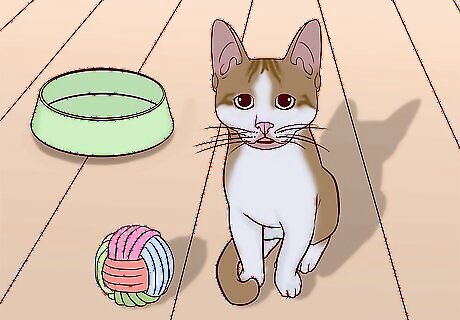
Listen for short yips, mews, and chirps, which mean the cat is happy. When you hear shorter, quieter noises from your cat, observe them to see what they're doing. These are normally signs that they want you to know that they're there and might want you to follow them somewhere. Sometimes, chirps can mean that the cat is "hunting" something, like a bird or a cat toy. Often, the cat just wants you to know that it’s excited! Cats will frequently make these noises when it’s time for food or when they are communicating with another animal.
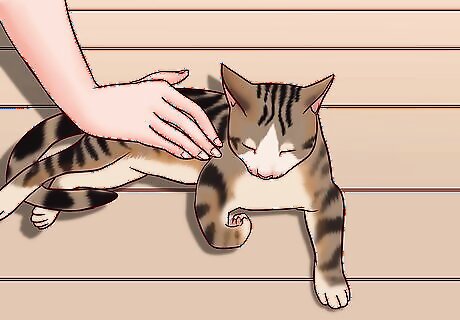
Enjoy the cat’s purring, which signals friendliness and contentment. When you’re petting and playing with your cat, listen closely for a low, rumbling noise from their throat. Keep petting, playing, or feeding the cat in the same way, as this is a sign that they’re feeling happy and want it to continue. Once the purring subsides, it’s okay to remove your hand. Cats can easily become overstimulated, so be sure to pay attention to the noises and body language cues that they make.
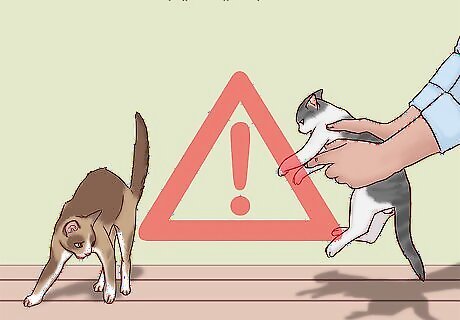
Be alert when you hear loud, long growls, yowls, or wails. These sounds are signs that something is wrong with a cat. When you hear these noises, look at the cat's posture to see if it looks like they're in pain or scared. Wailing is often a signal that an intact (non-spayed) female cat is in heat, so keep her indoors and away from male cats if you don’t want a litter of kittens. If you have more than one cat, growling can be a sign that two cats are about to fight. Try to separate them as quickly as possible to prevent injury. Prolonged, repetitive yowling often occurs when a cat is in profound pain, and you should get medical help quickly. Since cats instinctively hide their pain to avoid predators, they might be seriously ill.
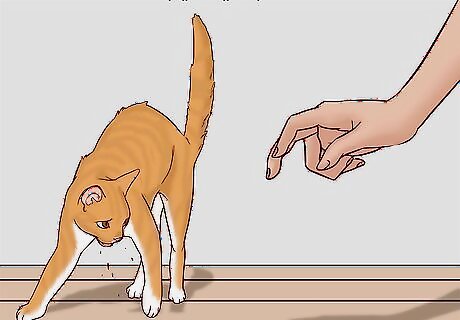
Back away and stay quiet when a cat hisses or spits. When a cat is threatened, they will pull back their gums to show their teeth and make a hissing noise. If you see this occur or feel the cat begin to spray saliva, remove yourself from the immediate area, preferably out of the cat’s sight. Often, the cat will stay where they are and gradually calm down. Never try to pick up or touch a hissing cat. They can bite and scratch you, which can cause serious injuries.
Understanding Cat Body Language
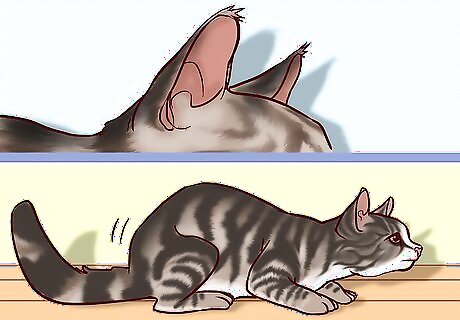
Play with the cat when they crouch with their ears forward. When a cat is feeling playful and excitable, they will crouch on their front legs and flick their tail. Use toys, a string, or a feature to lure the cat into pouncing, running, or pawing to play. Keep playing until the cat walks away or begins to use their claws. Keep in mind that when a kitten is learning how to play, they will often bite and scratch to see what they can get away with, since they don't know what will hurt you.Tip: If the cat is being too rough while you’re playing, mimic the sounds of a hurt cat by loudly yowling or wailing. This will signal to the cat that it’s hurting you and that it needs to be more gentle. If it continues to be rough, walk away from the cat to signal the end of play time.
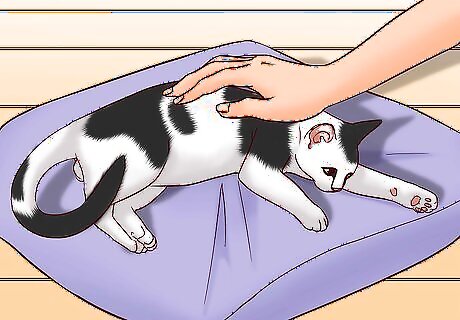
Pet the cat when they're lying down with their tail still and ears pointed forward. Observe your cat by looking at their posture as they lie on their belly or side. If the eyes are partially closed and the cat is still, run your hand along the top of their head and back. If the cat stays in one place, try petting their sides, face, and tail to see how they respond. If the cat shrinks away from your touch or gets up, stop petting them. They may be trying to take a nap!
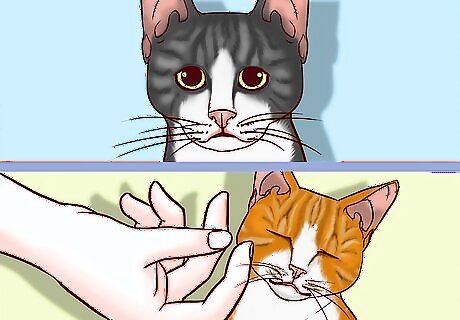
Look at the cat's eyes to see if they're relaxed and content. When a cat squints or closes their eyes, this is a sign of happiness and relaxation. Watch your cat's eyes as you pet them to see where they like to be scratched. If you want to tell your cat that you love them, you can slowly blink your eyes at them as a form of communication. When you slow-blink at your cat, try moving your head from side to side. Sometimes, if the cat is happy and relaxed, they will mimic your movements to show you that they understand what you're saying.
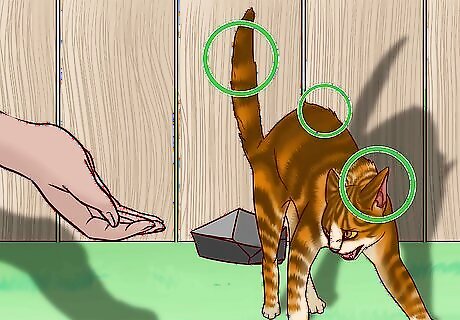
Keep away from a cat with flattened ears or fluffed fur. Cats use their ears and fur to signal when they’re hunting, threatened, or irritated. Look at the ears to see if they’re pointed straight out to the sides or toward the back of the head. If the cat's back and tail fur is standing on end, slowly move away to make sure they aren’t frightened or threatened, which can cause them to attack. Many cats will fluff their hair when they’re momentarily frightened, especially by loud noises. If your cat looks scared, try to find the object that they’re looking at and remove it from their sight.
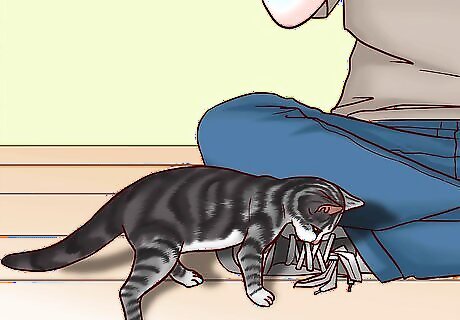
Allow the cat to rub against you to mark you with their scent. When you first enter into a cat’s territory, they may approach you. Stand still for a moment to allow them to rub against your legs, hands, and clothing, which makes you smell more like them. This is particularly important for indoor cats, because the outside can smell unusual and threatening to them, causing stress. Cats can also accomplish this by rubbing their face against your hands while you pet them.
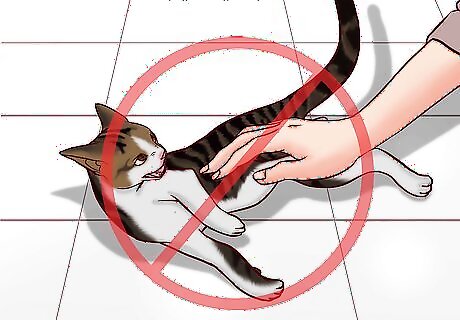
Avoid petting the cat’s stomach, even if they're lying on their back. If you come across a cat laying on their back with their belly and paws in the air, try scratching their head or sides. A cat shows their stomach as a sign of trust, and if you touch it, they might claw or bite you to signal that you broke their trust. Your cat may show you their stomach to say hello when you come home from work or to greet a new visitor.
Speaking to a Cat
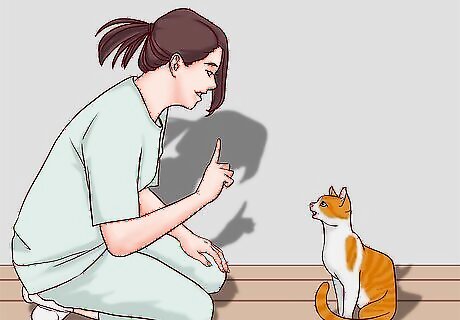
Be consistent about the tone and gestures that you use to communicate. Unlike dogs, cats aren't likely to respond to verbal commands alone, so rely on your tone, facial expressions, and hand movements to to talk to your cat. If you change your tone or gestures, this can confuse the cat and make communication more difficult. When dealing with kittens, remember to exaggerate your emotions so they can easily understand when you’re reacting positively or negatively.
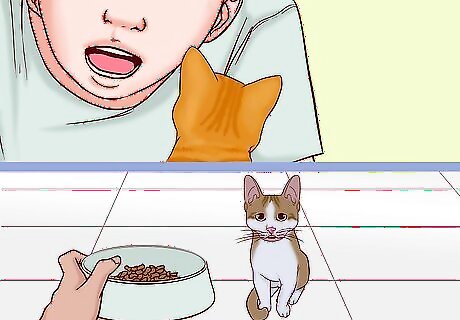
Talk in a high-pitched, happy voice when praising or feeding the cat. Associate positivity with feeding, play time, and petting. Speak in a clear, cheerful voice and make eye contact with the cat so they know you’re speaking to them. If the cat is resting, keep your voice quieter but still happy and positive. Since cats have large ears, they tend to be more sensitive to loud noises. If you frequently have to yell to get your cat’s attention, take the cat to the vet to have their hearing checked.
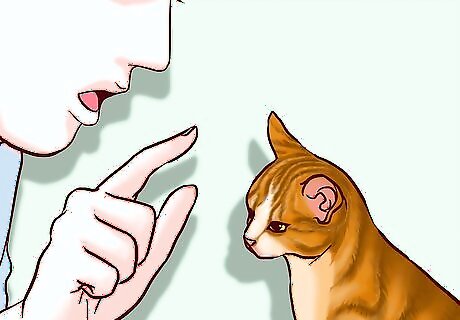
Speak in a firm voice when correcting the cat’s behavior. Use an authoritative, louder voice (but don't shout!) when the cat does something that isn’t allowed. Say “No!” or “Down!” to alert your cat that you’re displeased with a negative tone. In general, try to use the same words when you’re disciplining the cat. Using too many or too long words can be confusing.
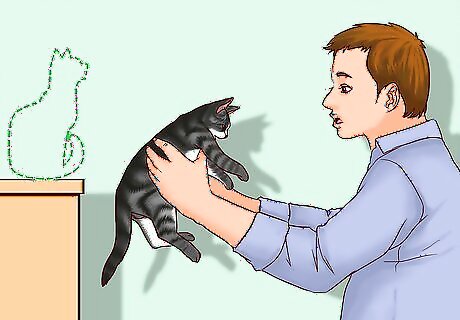
Couple words with touch to communicate with your cat. When praising the cat, try petting their fur and speaking in a high voice to associate that tone with a positive experience. If you’re correcting a behavior, carefully move the cat away from the place where they misbehaved as you say “No” or “Down” in a stern tone. Never discipline a cat by harming them. This is ineffective and can seriously hurt the cat. In many areas, it is illegal to intentionally hurt an animal.




















Comments
0 comment